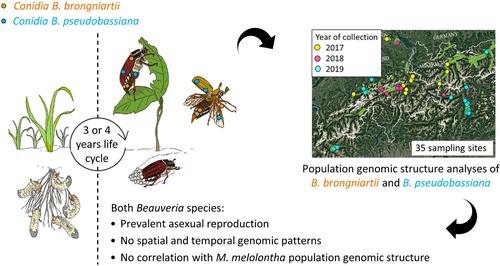当前位置:
X-MOL 学术
›
Environ. Microbiol.
›
论文详情
Our official English website, www.x-mol.net, welcomes your
feedback! (Note: you will need to create a separate account there.)
Clonal genomic population structure of Beauveria brongniartii and Beauveria pseudobassiana: Pathogens of the common European cockchafer (Melolontha melolontha L.)
Environmental Microbiology ( IF 4.3 ) Pub Date : 2024-04-15 , DOI: 10.1111/1462-2920.16612 Chiara Pedrazzini 1, 2 , Stephen A Rehner 3 , Hermann Strasser 4 , Niklaus Zemp 5 , Rolf Holderegger 2, 6 , Franco Widmer 1 , Jürg Enkerli 1
Environmental Microbiology ( IF 4.3 ) Pub Date : 2024-04-15 , DOI: 10.1111/1462-2920.16612 Chiara Pedrazzini 1, 2 , Stephen A Rehner 3 , Hermann Strasser 4 , Niklaus Zemp 5 , Rolf Holderegger 2, 6 , Franco Widmer 1 , Jürg Enkerli 1
Affiliation

|
Beauveria brongniartii is a fungal pathogen that infects the beetle Melolontha melolontha, a significant agricultural pest in Europe. While research has primarily focused on the use of B. brongniartii for controlling M. melolontha, the genomic structure of the B. brongniartii population remains unknown. This includes whether its structure is influenced by its interaction with M. melolontha, the timing of beetle-swarming flights, geographical factors, or reproductive mode. To address this, we analysed genome-wide SNPs to infer the population genomics of Beauveria spp., which were isolated from infected M. melolontha adults in an Alpine region. Surprisingly, only one-third of the isolates were identified as B. brongniartii, while two-thirds were distributed among cryptic taxa within B. pseudobassiana, a fungal species not previously recognized as a pathogen of M. melolontha. Given the prevalence of B. pseudobassiana, we conducted analyses on both species. We found no spatial or temporal genomic patterns within either species and no correlation with the population structure of M. melolontha, suggesting that the dispersal of the fungi is independent of the beetle. Both species exhibited clonal population structures, with B. brongniartii fixed for one mating type and B. pseudobassiana displaying both mating types. This implies that factors other than mating compatibility limit sexual reproduction. We conclude that the population genomic structure of Beauveria spp. is primarily influenced by predominant asexual reproduction and dispersal.
中文翻译:

布氏白僵菌和拟白僵菌的克隆基因组群体结构:欧洲常见金龟子(Melolontha melolontha L.)的病原体
布氏白僵菌是一种真菌病原体,可感染欧洲重要的农业害虫甲虫Melolontha melolontha 。虽然研究主要集中在使用布氏木虱来控制M. melolontha ,但布氏木虱种群的基因组结构仍然未知。这包括其结构是否受到与M. melolontha的相互作用、甲虫群飞行的时间、地理因素或繁殖模式的影响。为了解决这个问题,我们分析了全基因组 SNP,以推断白僵菌的群体基因组,白僵菌是从阿尔卑斯地区受感染的M. melolontha成虫中分离出来的。令人惊讶的是,只有三分之一的分离株被鉴定为B. brongniartii ,而三分之二分布在B.pseudobassiana内的隐秘类群中,这是一种以前未被认为是M. melolontha病原体的真菌物种。鉴于白僵菌的流行,我们对这两个物种进行了分析。我们发现这两个物种内没有空间或时间基因组模式,并且与M. melolontha的种群结构没有相关性,这表明真菌的传播独立于甲虫。两个物种都表现出克隆群体结构,其中B. brongniartii固定为一种交配类型,而B. pseudobassiana则显示两种交配类型。这意味着交配兼容性以外的因素限制了有性繁殖。我们得出结论,白僵菌的群体基因组结构。主要受无性繁殖和传播的影响。
更新日期:2024-04-15
中文翻译:

布氏白僵菌和拟白僵菌的克隆基因组群体结构:欧洲常见金龟子(Melolontha melolontha L.)的病原体
布氏白僵菌是一种真菌病原体,可感染欧洲重要的农业害虫甲虫Melolontha melolontha 。虽然研究主要集中在使用布氏木虱来控制M. melolontha ,但布氏木虱种群的基因组结构仍然未知。这包括其结构是否受到与M. melolontha的相互作用、甲虫群飞行的时间、地理因素或繁殖模式的影响。为了解决这个问题,我们分析了全基因组 SNP,以推断白僵菌的群体基因组,白僵菌是从阿尔卑斯地区受感染的M. melolontha成虫中分离出来的。令人惊讶的是,只有三分之一的分离株被鉴定为B. brongniartii ,而三分之二分布在B.pseudobassiana内的隐秘类群中,这是一种以前未被认为是M. melolontha病原体的真菌物种。鉴于白僵菌的流行,我们对这两个物种进行了分析。我们发现这两个物种内没有空间或时间基因组模式,并且与M. melolontha的种群结构没有相关性,这表明真菌的传播独立于甲虫。两个物种都表现出克隆群体结构,其中B. brongniartii固定为一种交配类型,而B. pseudobassiana则显示两种交配类型。这意味着交配兼容性以外的因素限制了有性繁殖。我们得出结论,白僵菌的群体基因组结构。主要受无性繁殖和传播的影响。
















































 京公网安备 11010802027423号
京公网安备 11010802027423号